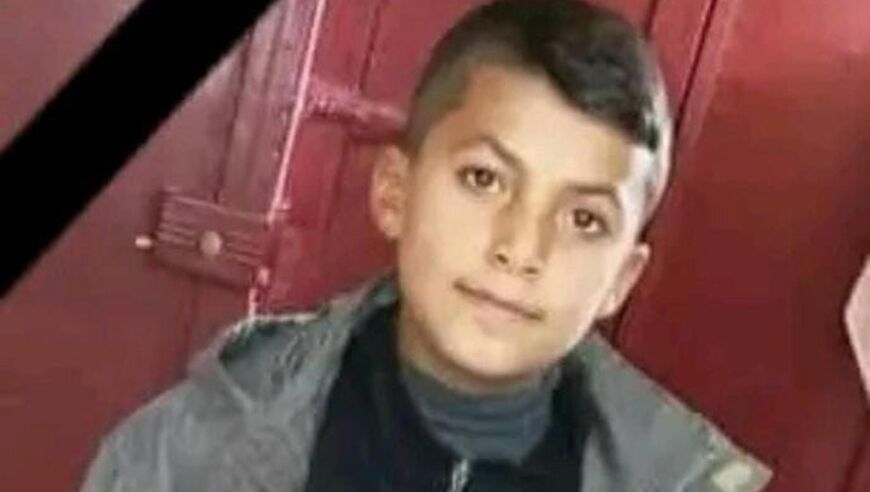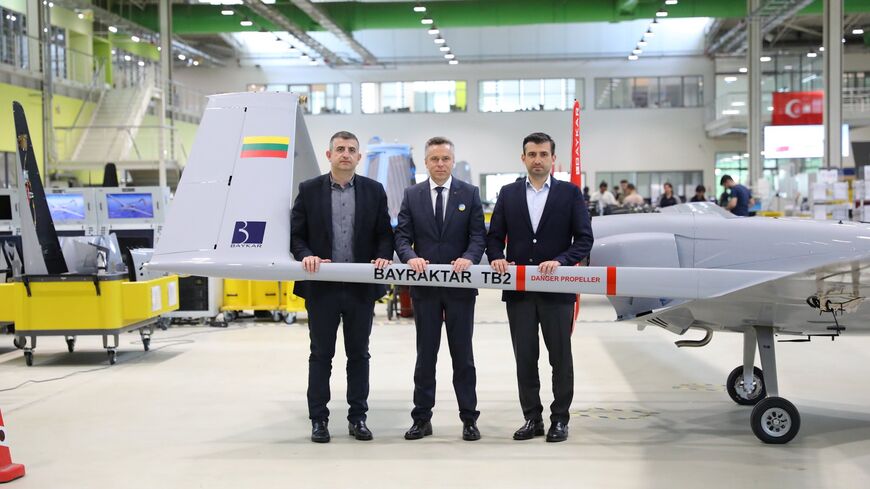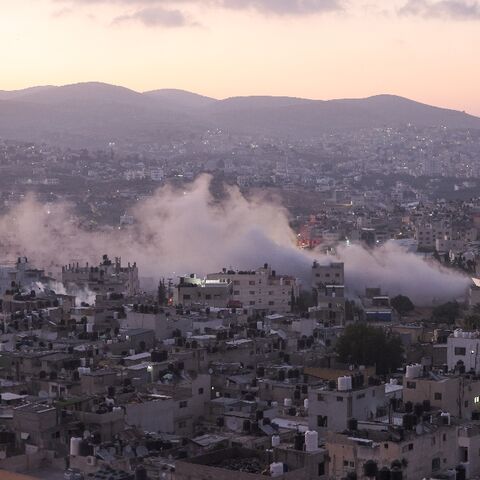AL-DARBASIYAH, Syria — Ahmed Abed Al Khani Salam, the 11-year-old son of impoverished farmers from rural Tell Hamis in Kurdish-run northeast Syria, had big dreams. In September 2022, he began working in a popular roadside supermarket on the main road running from the Iraqi border to the area’s informal capital, Qamishli. “Mama, I will rise to become a manager here. I will earn and send you more money. Believe me,” the boy would tell his mother over the phone after bookkeeping lessons from the store’s accountant. “He was bright, hardworking and big-hearted,” recalled the shop’s owner, Ari Ahmed Abdurrahman, on a recent afternoon.
Four months later, little Ahmed lay lifeless in a pool of blood near the shop’s cash register, yet another victim of Turkey’s deadly drone attacks on alleged terrorists in northeast Syria.
Video footage of the strike on Jan. 18, captured by the Ari Market’s multiple security cameras, documents the full horror of that moment. A man is seen settling his bill with Abdurrahman. Within seconds, another man — the customer’s brother who is carrying a little girl and holding a second one’s hand — walks through the door. They fall to the ground as the floor shakes and black smoke fills the shop.
A split second prior, a pickup truck exploded into a ball of fire as it pulled up beside the supermarket. Both passengers, the intended targets, died in the blast. “The customer was buying ice cream and potato chips for his nieces. He was 40 years old. He died together with the child Ahmed right before my eyes,” Abdurrahman told Al-Monitor.

Undated photo of Ahmed Abed Al Khani Salam, who died in an alleged Turkish drone strike near Qamishli on Jan. 18, 2023. (photo courtesy of Salam family)
Ahmed had taken the job to support his family after his dad fell ill. American Special Forces who were deployed in the region as part of the US-led coalition against the Islamic State (IS) were regulars at the Ari Market, where everything from Soviet-era bric-a-brac to Damascene sweetmeats line the shelves. “The American forces came to visit us to offer their condolences. They took pictures of the damage,” Abdurrahman said.
Business has plummeted since the incident.
Degrade and destroy
The drone strikes are part of Turkey’s systematic campaign to degrade and destroy the Kurdish-led Autonomous Administration in North and East Syria (AANES).
Turkey views the Syrian Kurds' experiment in self-rule as a major threat that will further foment separatism among its own rebellious Kurds. Since 2016, it has launched three major ground offensives against the Syrian Kurdish People’s Protection Forces (YPG), which forms the backbone of the Syrian Democratic Forces (SDF), the US-led coalition’s top partner against IS.
Turkey justifies such aggression on the grounds that the YPG, and by extension the SDF, are run by another Kurdish group, the Kurdistan Workers Party (PKK), which has been waging an armed campaign for Kurdish autonomy against the Turkish state for almost 40 years.
Many of the YPG’s top commanders rose through the ranks of the PKK, which is listed as a terrorist organization by the United States and the European Union. They openly pledge fealty to imprisoned PKK leader Abdullah Ocalan, whose portrait is plastered on giant billboards across Rojava.

Ari market, where an alleged Turkish drone killed two Kurdish civilians on Jan. 18, 2023, is pictured on April 24, 2023. (photo by Amberin Zaman)
The YPG and the SDF deny any organizational ties with the PKK, though it is widely known that the PKK maintains a shadow presence on the ground. Many ordinary Kurds probably may not agree with the PKK’s left-wing ideology and authoritarian bent. However, in the event of a US withdrawal, they view the rebels as their best line of defense.
Washington and the Kremlin have pushed back against Turkish President Recep Tayyip Erdogan’s repeated demands to launch another ground invasion in northeast Syria. Its aim would be to drum up nationalist support ahead of the watershed presidential and parliamentary polls that are due to take place on May 14. In response, Turkey’s national spy agency, MIT, has escalated drone attacks, “neutralizing” alleged PKK targets in northern Syria as well as in northern Iraq, and proudly trumpets the results on social media.
“Turkey's drone program, like the rest of the country's growing state-linked defense industry, exists almost exclusively because of Turkey's war on Kurdish armed groups and civilians both within its borders and in neighboring Iraq and Syria,” observed Meghan Bodette, director of research at the Washington-based Kurdish Peace Institute. “Drone exports to Ukraine strengthen that state-linked defense industry and have provided Erdogan's government with political capital on the international stage — both of which bolster militaristic approaches to the Kurdish issue,” Bodette told Al-Monitor.

Portraits of Abdullah Ocalan, the imprisoned PKK leader, are ubiquitous in northeast Syria. (photo by Amberin Zaman, April 25, 2023)
Salih Muslim, co-chair of the Democratic Unity Party that shares power in the AANES, doesn’t mince words. “Turkey is bent on exterminating Kurds wherever it sees them, be they here in Rojava (Syrian Kurdistan) or in Bashur (Iraqi Kurdistan),” Muslim told Al-Monitor during an April 24 interview at an SDF base in northeast Syria. Muslim — who studied chemical engineering in Istanbul, speaks fluent Turkish and used to meet with Turkish diplomats when Turkey was in peace talks with its own Kurds — is on Ankara’s list of most-wanted terrorists.
Filming and killing
Turkey’s Bayraktar drones, which have risen to near cult status in Ukraine, are produced by Baykar, an Istanbul-based company that cannot keep up with orders pouring in from across the globe. The fabled TB2 was designed by Selcuk Bayraktar, who runs it together with his older brother Haluk. Bayraktar is married to Erdogan’s younger daughter and favorite child, Summeye, who has a keen interest in foreign affairs. Slick videos showing Bayraktar pulling Top Gun poses and the couple hugging children left homeless by the massive earthquakes in February have received millions of views. The steady stream of propaganda has fed speculation that Turkey’s strongman is prepping Bayraktar as his successor. The drones and other locally produced hardware have become a central theme of Erdogan’s electoral campaign.

Selcuk Bayraktar (right) at a ceremony with Lithuanian officials to hand over a TB2 drone intended for Ukraine. (Twitter/BaykarTech)
In a recent interview with the German weekly Der Spiegel, Bayraktar denied any political ambitions. The 43-year-old also brushed off criticism of the drones. “He argues that drones are more accurate than other weapons, and because the attacks are filmed, he insists there is greater accountability,” the magazine reported.
No such accountability is in evidence in northeast Syria where at least 87 people died in Turkish drone strikes last year, according to the Rojava Information Center, an independent research outfit based in northeast Syria. Some 25 of the victims were civilians. Nine of them were children.
Few, if anyone, in Turkey will have heard of Slava Ramadan, a bubbly Syrian Kurdish 16-year-old who adored animals and loved to act and sing. The top student in her class, Slava was 9 when she won plaudits for her role in a locally produced film. Slava’s talent drew the attention of the local administration, who persuaded her parents to enroll her in Shamoka, that was described by local media as a UN-funded education center for girls and is located about 1.5 kilometers from a US-led coalition base in Hasakah.

Ramziya and Azad Ramadan, whose 16 year old daughter Slava was killed in a Turkish drone strike on Aug. 18, 2022, seen at their family home in al-Darbasiyah on April 26, 2023. (photo by Amberin Zaman)
Slava, whose name means “greetings” in Kurdish, was playing volleyball in the school courtyard on Aug. 18 when a Turkish drone struck, killing four of her schoolmates and wounding 11 others. The dead girls were identified by local media as child fighters demobilized under a UN scheme. Slava, who had never taken up arms according to her family, eventually succumbed to her burns. Maj. Gen. John Brennan, commander of the US-led coalition, condemned the attack. “Such acts are contrary to the laws of armed conflict, which require the protection of civilians,” he said.
The United Nations aired its “deep concern.” Turkey was never mentioned by name.
Slava’s mother Ramziya and father Azad only learned of the attack a day later while watching television. The couple rushed to the main hospital in Hasakah where they were told that Slava had been flown for treatment to the city of Sulaimaniyah in Iraqi Kurdistan. Coalition forces had likely ferried her there.
The Kurdistan Regional Government, which is closely allied with Ankara, denied the Ramadans’ request to travel to Sulaimaniyah, citing bureaucratic procedures that would take a month. “My daughter died alone,” Ramziya told Al-Monitor, her body stiffening as she strained to hold back her tears. “When we received her body, her sweet face, it wasn’t touched. But her body was charred. It was black. Seeing my child like that was very painful. It was like losing part of my soul.”
“She died on Sept. 1, World Peace Day. Erdogan made that day horrible for us,” Azad said as he showed a reporter photographs of his daughter on a mobile phone.
“It was obviously a school. They knowingly killed schoolchildren. Why?” he asked.
Off the hook
The question is a pertinent one. As Bayraktar said, the attacks are filmed. “Drone operators can observe the target for a very long period with high-definition cameras and thus can avoid taking a strike that could affect civilians. If you are still killing civilians, that means you are not doing your job well. And this raises the accountability for states that carry out targeted killings with drones,” said Wim Zwijnenburg, project leader for humanitarian disarmament at PAX, a Dutch peace organization.
“Turkey needs to provide a clear legal justification for the strikes themselves, as they must prove how these individuals posed an imminent threat to Turkish national security that could not have been addressed through nonlethal means,” Zwijnenburg told Al-Monitor.

Slava Ramadan’s grave at the Rustem Cudi graveyard for martyrs outside Al Darbasiyah, April 26, 2023. (photo by Amberin Zaman)
The fact that no foreign government apart from the Catalan parliament formally recognizes the Syrian Kurds’ quasi-statelet makes it impossible for it to press victims’ cases with international legal bodies. “The most we can do is to tell foreign officials of the tragedies unfolding in our region, and weep,” Muslim said.
To make matters worse, Turkey — a NATO member — has seen its strategic value rise as a result of the Ukraine conflict, allowing it to act with even greater impunity. The brazenness was on full display when Turkey carried out a drone strike near a convoy carrying SDF commander Mazlum Kobane on April 7 and US military officials near Sulaimaniyah’s international airport.
The Pentagon condemned the attack. However, the White House and the State Department did not utter a word.
Meanwhile, Sweden and Finland lifted arms bans slapped on Turkey by EU nations in the wake of its 2019 invasion of northeast Syria in a bid to secure Ankara’s support for their adhesion to NATO. The UK dropped the sanctions as soon as it quit the European bloc.
However, the US Congress, which imposed similar restrictions, continues to ignore the Biden administration’s call to allow the sale of F-16 fighter jets to Turkey, citing that country's human rights record.
Indeed, there is growing scrutiny of Turkish abuses.
Conflict Armament Research, an international watchdog, said in a recent report that it had established that the remnants of 17 air-to-surface missile attacks in northeast Syria were all part of the MAM series made in Turkey “and were likely fired by UAVs (drones).”
The London-based body determined that some of the missile's components were manufactured in the European Union. They included electromagnetic brakes sold to be used in ambulances in Turkey but that were “incorporated into missiles for use in northeast Syria,” the report said. The manufacturer, a Dutch company, was shamed into halting sales.
The United Nations Human Rights Council has named Turkey, albeit gingerly, in several recent reports on Syria. The most recent report references several artillery and drone strikes affecting civilians. These include a Jan. 8 shelling attack on the border town of Kobani, of which the UN noted, “Photographs of remnants from one of the villages where civilians were injured indicates the use of unguided 120 mm mortars, which, given the range of the weapon, may have been fired from [Turkey].”
“There are reasonable grounds to believe that the use of unguided explosive weapons to strike urban areas and villages amounts to the war crime of launching an indiscriminate attack causing death and injury to civilians,” the UN added.
Life after death
Such words are of little comfort to Faiza and Ali Hussain, who lost their 18-year-old son Ahmed and their 16 year old nephew Aheng in a Turkish drone strike on Aug. 6 of last year. Ali was with the boys at his agricultural machinery repairs shop in Qamishli’s Sinna industrial zone when the drone hit a suspected military vehicle carrying alleged SDF officials. One was later identified as Rezan Javid, the former commander of the PKK’s Iranian wing, PEJAK, who was interviewed by this author near the Iranian border in 2015.
Hussain said he heard a hissing sound — “like pfishttt” — seconds before the blast. “Then there was blood, body parts and pieces of flesh splattered everywhere,” Hussain told Al-Monitor during a tour of the street where the drone released its payload. Measuring roughly seven meters wide, it is lined with workshops filled with soot-covered boys.
“See, feel it,” said Hussain, running a journalist's finger over his chest. Fragments of shrapnel remain embedded in it. The mechanic who now limps underwent surgery to remove fragments lodged inside his body during the explosion, but needs a second one.

Faiza and Ali Hussain posing in front of their son Ahmed’s motorbike in Qamishli on April 26, 2023. Ahmed, 18, was killed in a Turkish drone strike on Aug. 6, 2022. (photo by Amberin Zaman)
In an emailed response to Al-Monitor’s request for comment, CAR said it was not able to independently examine and verify the recovered fragments from the Sinna strike but that it had received detailed photographs from the local security forces. “Based on analysis of available photographs, it appears the fragments recovered in Sinaa neighborhood were consistent with the remains of a MAM-L or MAM-T [guided] munition,” manufactured by Turkey’s Roketsan.
Back in the family home, Faiza motions towards a shiny new motorbike propped inside the living room. “It was my Ahmed’s pride and joy,” she said as she broke down in tears. “He was a very, very good boy. He loved his job. He loved life. What did we do to the Turks, that they did this to us?”
Faiza says she feels paralyzed now and can no longer muster the courage to venture outside. “I am afraid of the drones,” she said. Minutes later, she confides that she is expecting a baby. Faiza is due in six months. “I am scared to bring another child into the world. What if the Turks kill it too?” she asked.








